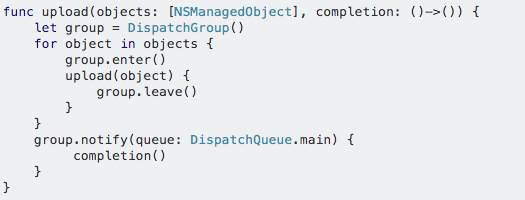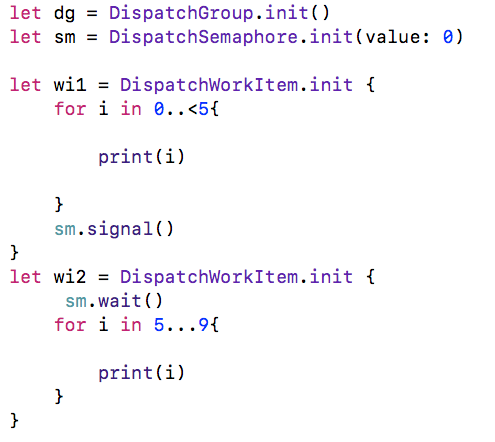Operation and Grand Central Dispatch interview questions
Operation and Grand Central Dispatch interview questions
Multithreading iOS interview questions, gcd, operation, operation queue
In this article, i am going to cover questions and concept related to GCD , multi-threading and operation. Lets start..
GCD
Its operating at the system level, can better accommodate the needs of all running applications, matching them to the available system resources in a balanced fashion.
Managing Dispatch Queues
GCD provides and manages FIFO queues to which your application can submit tasks in the form of block objects. Work submitted to dispatch queues are executed on a pool of threads fully managed by the system. No guarantee is made as to the thread on which a task executes.
Synchronous and Asynchronous Execution
Each work item can be executed either synchronously or asynchronously. When a work item is executed synchronously with the sync method, the program waits until execution finishes before the method call returns. When a work item is executed asynchronously with the async method, the method call returns immediately.
Serial and Concurrent Queues
A dispatch queue can be either serial, so that work items are executed one at a time, or it can be concurrent, so that work items are dequeued in order, but run all at once and can finish in any order. Both serial and concurrent queues process work items in first in, first-out (FIFO) order.
DispatchTypes:
DispatchWorkItem
DispatchWorkItem
encapsulates work that can be performed. A work item can be
dispatched onto a
DispatchQueue
and within a
DispatchGroup.
A
DispatchWorkItem
can also be set as a
DispatchSource
event, registration, or cancel handler.
DispatchSemaphore
DispatchSemaphore
provides an efficient implementation of a traditional counting
semaphore, which can be used to control access to a resource
across multiple execution contexts.
DispatchGroup
DispatchGroup
allows for aggregate synchronization of work. You can use them
to submit multiple different work items and track when they all
complete, even though they might run on different queues. This
behavior can be helpful when progress can’t be made until all of
the specified tasks are complete.
DispatchData
DispatchData
objects manage a memory-based data buffer. The data buffer is
exposed as a contiguous block of memory, but internally, it may
be comprised of multiple, discontiguous blocks of memory.
DispatchTime
DispatchTime
represents a point in time relative to the default clock with
nanosecond precision. On Apple platforms, the default clock is
based on the Mach absolute time unit.
DispatchSource
DispatchSource
provides an interface for monitoring low-level system objects
such as Mach ports, Unix descriptors, Unix signals, and VFS
nodes for activity and submitting event handlers to dispatch
queues for asynchronous processing when such activity occurs.
DispatchIO
DispatchIO
provides a channel to perform operations on file descriptor
using either stream-based and random-access semantics for
accessing the contents of a file descriptor.
DispatchObject
DispatchObject
is the base class for many dispatch types, including
DispatchQueue,
DispatchGroup, and
DispatchSource.
Benefits of
Operation
1. Operation Dependencies
Dependencies are a convenient way to execute operations in a
specific order. You can add and remove dependencies for an
operation using the
addDependency(_:)
and
removeDependency(_:)
methods. By default, an operation object that has dependencies
is not considered ready until all of its dependent operation
objects have finished executing. Once the last dependent
operation finishes, however, the operation object becomes ready
and able to execute.
The dependencies supported by
Operation make
no distinction about whether a dependent operation finished
successfully or unsuccessfully. (In other words, canceling an
operation similarly marks it as finished.) It is up to you to
determine whether an operation with dependencies should proceed
in cases where its dependent operations were cancelled or did
not complete their task successfully. This may require you to
incorporate some additional error tracking capabilities into
your operation objects.
2. KVO-Compliant Properties
The
NSOperation
class is key-value coding (KVC) and key-value observing (KVO)
compliant for several of its properties. As needed, you can
observe these properties to control other parts of your
application. To observe the properties, use the following key
paths:
-
isCancelled- read-only -
isAsynchronous- read-only -
isExecuting- read-only -
isFinished- read-only -
isReady- read-only -
dependencies- read-only -
queuePriority- readable and writable -
completionBlock- readable and writable
Although you can attach observers to these properties, you should not use Cocoa bindings to bind them to elements of your application’s user interface. Code associated with your user interface typically must execute only in your application’s main thread. Because an operation may execute in any thread, KVO notifications associated with that operation may similarly occur in any thread.
3. Maintaining Operation Object States
Operations can be paused, resumed, and cancelled. Once you dispatch a task using Grand Central Dispatch, you no longer have control or insight into the execution of that task.
When to use Operation or Grand Central Dispatch?
If you need to perform several tasks in a specific order, then operations are a good solution i.e. if you are going to utilize benefits of operation then only go for it.
Grand Central Dispatch is ideal if you just need to dispatch a block of code to a serial or concurrent queue, other benefit is that you can keep related code together.
Question’s Time:
1. Write a code that shows thread-safety issues?

This problem is called a race condition and can always happen if multiple threads access a shared resource without making sure that one thread is finished operating on a resource before another one begins accessing it.
2. When should we suspect a race condition?
When variables that have multiple threads operating on them and you’re getting unexpected results some of the time.


3. How do you handle race condition in iOS?
In order to prevent this, multiple threads need to access shared resources in a mutually exclusive way.

4. What are the Challenges of Concurrent Programming?
- Sharing of resources or race condition
- Mutual exclusion
- Deadlocks
- Starvation
- Priority inversion
5. How can you achieve mutual exclusion in iOS ?
There are several ways to achieve this kind of lock. But I think dispatch semaphore is better than others because it seems to have the least overhead. As found in Apples doc, “Replacing Semaphore Code”, it doesn’t go down to kernel space unless the semaphore is already locked (= zero), which is the only case when the code goes down into the kernel to switch the thread. I think that semaphore is not zero most of the time (which is of course app specific matter, though). Thus, we can avoid lots of overhead.
One more comment on dispatch semaphore, which is the opposite scenario to above. If your threads have different execution priorities, and the higher priority threads have to lock the semaphore for a long time, dispatch semaphore may not be the solution. This is because there’s no “queue” among waiting threads. What happens at this case is that higher priority threads get and lock the semaphore most of the time, and lower priority threads can lock the semaphore only occasionally, thus, mostly just waiting. If this behavior is not good for your application, you have to consider dispatch queue instead.
6. Write a code to generate deadlock?
More resources you share between threads and the more locks you take, the greater your risk of running into a dead lock situation

7. How will you solve deadlock in iOS for above question?

8. How will you solve Starvation/Readers-Writers problem in iOS for above question?
Locking shared resources can result in the readers-writers problem. In many cases, it would be wasteful to restrict reading access to a resource to one access at a time. Therefore, taking a reading lock is allowed as long as there is no writing lock on the resource. In this situation, a thread that is waiting to acquire a write lock can be starved by more read locks occurring in the meantime.
Using concurrent queues with barriers helps us improve and speed up our code while eliminating the readers-writers problem

9. What is Priority Inversion?
Priority inversion describes a condition where a lower priority task blocks a higher priority task from executing, effectively inverting task priorities. Since GCD exposes background queues with different priorities, including one which even is I/O throttled, it’s good to know about this possibility.
10. Write a code to print number in sequence while two threads are responsible for printing even and odd numbers?

Note: You can use the semaphore in 2 different ways:
-
To say when work or a resource is ready. In this case you
start the semaphore at 0. The creator calls
signalwhen something is ready. The consumer callswaitto wait for the expected item / resource. -
To limit the number of concurrent operations / requests /
usages. In this case you start the semaphore at a positive
value, like 4. The users each call
waitand if resource is available they are allowed to continue. If not they are blocked. When each has finished with the resource they callsignal.
11. Write a code for adding dependency between two concurrent threads using semaphore?

Terminology:
- Race Condition A race condition occurs when two or more threads can access shared data and they try to change it at the same time.
- Deadlock A deadlock occurs when two or sometimes more tasks wait for the other to finish, and neither ever does.
- Readers-Writers problem Multiple threads reading at the same time while there should be only one thread writing.
- Readers-writer lock Such a lock allows concurrent read-only access to the shared resource while write operations require exclusive access.
- Dispatch Barrier Block Dispatch barrier blocks create a serial-style bottleneck when working with concurrent queues.
References: